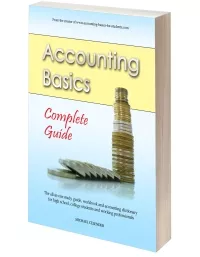Creditors, Purchases, Cost of Goods Sold Question and Answer
by Anonymous
Before you begin: It's important for testing and exams to make sure you not only answer questions correctly but also completed them at the right speed. Grab a pen and piece of paper and time yourself while attempting this exercise.
Difficulty Rating:
Intermediate
Time limit:
10 minutes
Balances at 31 January 2009:
Debtors control account.............................$32,400
Creditors control account...........................$25,200
Inventory...................................................$30,000
Balances at 28 February 2009:
Debtors control account.............................$24,000
Creditors control account...........................$29,160
Inventory...................................................$36,000
Extract from cash payments journal at 28 February 2009:
Payments to creditors.................................$41,040
Additional Information:
a) Gross profit mark-up is 20% on cost
b) Inventory is kept on the perpetual system
c) All purchases and 80% of sales are on credit
Required:
a) Calculate purchases.
b) If purchases during February were $39,000 what is the Cost of Goods Sold for February?
a) First of all, remember that "purchases" sometimes consists of both cash and credit purchases. In this example, however, it says, "all purchases and 80% of sales are on credit." This is a bit confusing, but if you read it carefully it means that all purchases here are on credit.
So how do we get all purchases or all credit purchases here?
If you reconstructed the creditors control T-account the answer would be the "balancing figure" in the T-account (the final missing figure there).
What I mean is, we can use the opening and closing balances of the creditors control, as well as the cash paid to them ("Payments to creditors") to get the credit purchases during the month.
Here's how I like to look at it:
- We started out owing the creditors control $25,200.
- We purchased a certain amount from them during the month (missing or balancing figure). This increases how much we would owe them. More purchases on credit means more owing.
- We also paid them
- At the end of the month (after all this) we owed them $29,160.
Now if you're not familiar with constructing a T-account to get a missing or balancing figure, you can also put the above items in the form of an equation:
Closing balance creditors control = Opening balance creditors control + Credit Purchases - Payments to Creditors
$29,160 = $25,200 + Credit Purchases - $41,040
If we switch this around and make Credit Purchases the subject:
Credit Purchases = $29,160 - $25,200 + $41,040
= $45,000
Since credit purchases make up 100% of the purchases, the full purchases figure is also $45,000.
b) Any time a question asks for the Cost of Goods Sold (or Cost of Sales - same thing) then there is a very good chance you will need to use the Cost of Goods Sold formula.
The cost of goods sold formula is:

Here's how we use it in this question:
Cost of Goods Sold = Opening inventory + Purchases - Closing Inventory
= $30,000 + $39,000 - $36,000
= $33,000
Isn't it interesting how they gave all this extra information in this question? Check the "additional information" section above. We didn't even need any of the information in a) and b) at all to get the answers!
TIP: It often helps to arrange things in a simple equation when you're trying to answer a question - try use equations wherever possible, especially when you're stuck!
Hope you enjoyed our Creditors, Purchases, Cost of Goods Sold Question and Answer!
What did you think of this exercise? Leave us a comment below.
Best,
Michael Celender
Founder of Accounting Basics for Students
Related Questions & Tutorials:
Click here for more Full Accounting Exercises
Comments for Creditors, Purchases, Cost of Goods Sold Question and Answer
|
||
|
||
|
||
© Copyright 2009-2023 Michael Celender. All Rights Reserved.
Click here for Privacy Policy.



